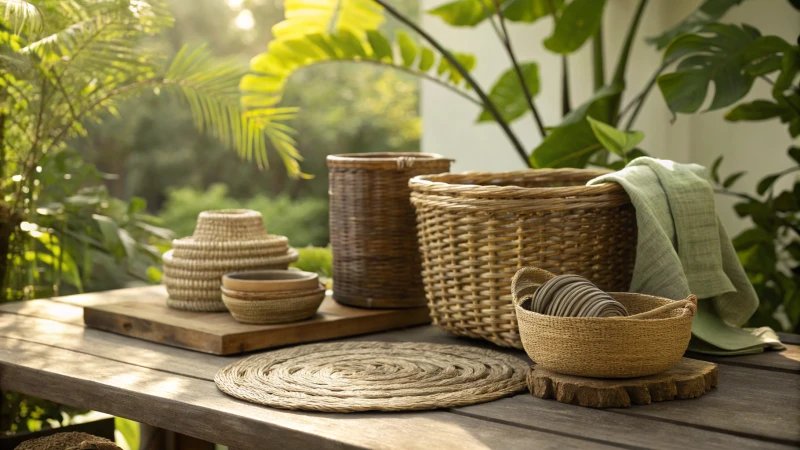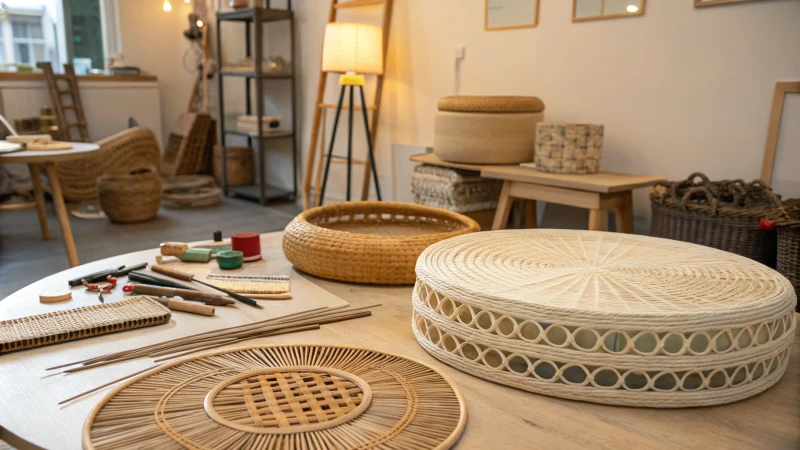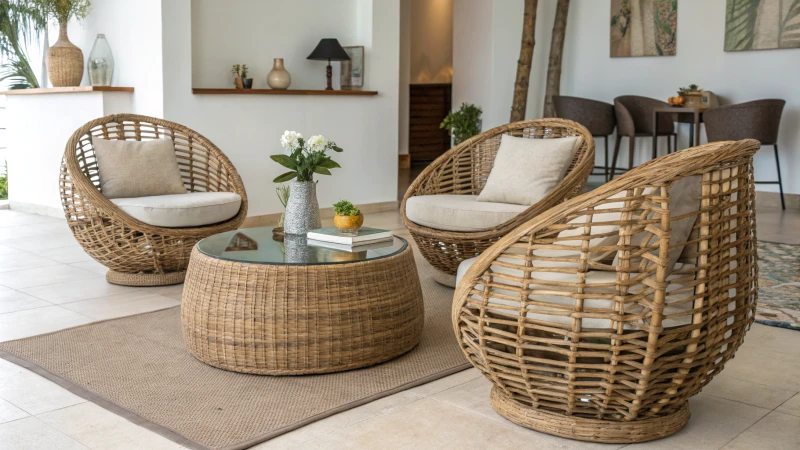
Step into the enchanting world of rattan with me!
There are several types of rattan. Each type has unique traits. These traits suit different uses in furniture and decor. Understanding these differences is very important. Choosing the right rattan depends on your project needs.
I remember when I first found rattan at a small market in Italy. The sunlight shone beautifully on its surface. Rattan has its own special charm and story. In this blog post, I share my journey exploring different types of rattan. I reveal their unique properties. They can really improve your design projects. You might be a seasoned professional or a DIY enthusiast just starting out. I hope this helps you choose the best for your creations.
Rattan types vary significantly in characteristics.True
Different rattan types possess unique properties that influence their suitability for various furniture and decor applications.
All rattan is suitable for outdoor furniture use.False
Not all types of rattan are durable enough for outdoor conditions; some are better suited for indoor use.
What Are the Main Types of Rattan?
I dive into the world of rattan and think of my first encounter with this adaptable material. It opened up new chances for furniture and décor. Let us explore the different kinds of rattan that probably transform your spaces!
Natural rattan, synthetic rattan, wicker rattan, flat rattan and round rattan are the main types. Each one has unique traits. These traits suit them perfectly for different furniture and craft projects.

Rattan is not just one type of material; it encompasses several varieties that differ in characteristics, applications, and aesthetic appeal.
1. Natural Rattan
Natural rattan is really special to me. This type comes directly from the rattan vine. It is famous for flexibility and strong durability. I once created my first furniture piece from natural rattan. Its ability to bend felt almost magical. Natural rattan works indoors and outdoors. Its warm and natural look fits many styles. Explore natural rattan options1 if you are curious.
2. Synthetic Rattan
My favorite for outdoor furniture is synthetic rattan. This man-made type looks like natural rattan. However, it withstands weather much better. I remember building a patio set with synthetic rattan. It resisted sun and rain very well.
| Feature | Natural Rattan | Synthetic Rattan |
|---|---|---|
| Durability | Moderate | High |
| Maintenance | Requires care | Easy to clean |
| Eco-friendliness | Biodegradable | Not biodegradable |
Check synthetic rattan types for more options.
3. Wicker Rattan
Wicker describes a weaving method for rattan materials. Wicker rattan furniture is lightweight and looks intricate. I find its designs very enchanting. It can fit traditional and modern spaces. Using wicker rattan adds versatility to any room.
For more information on its history and uses, visit wicker rattan styles.
4. Flat Rattan
Flat rattan is truly unique! Flat strips are perfect for weaving and basket-making. They offer a broad area for creative designs. I once made wall hangings from flat rattan. The patterns added much character to my home.
Discover creative ideas at flat rattan crafts.
5. Round Rattan
Round rattan combines strength and elegance. I enjoy using round poles in furniture frames. They provide strong support while being light. Their rounded shape creates beautiful curves, giving any piece a touch of sophistication.
Learn more about round rattan uses.
Natural rattan is derived from the rattan vine.True
This claim is true as natural rattan comes from the rattan vine, known for its flexibility and durability.
Synthetic rattan is biodegradable and eco-friendly.False
This claim is false; synthetic rattan is not biodegradable and is less eco-friendly compared to natural rattan.
What Makes Different Types of Rattan Unique in Durability?
Join me as I explore the amazing world of rattan. I will uncover how its different types influence your furniture choices. This journey will help you find the perfect fit for your needs.
Different rattan types have various levels of durability because of their material composition and treatment. Natural rattan requires careful maintenance. It often suffers from moisture damage. On the other hand, synthetic rattan resists environmental factors better. Synthetic rattan is therefore ideal for outdoor use. It really lasts longer outdoors.

Understanding Rattan Types
Rattan materials primarily fall into two categories: natural rattan and synthetic rattan. Each type exhibits varying levels of durability influenced by factors such as sourcing, treatment, and intended use.
-
Natural Rattan: Extracted from palm vines, natural rattan is known for its flexibility and aesthetic appeal. However, its durability can be compromised if not properly treated. It tends to absorb moisture, making it less suitable for outdoor use unless coated with protective finishes. I learned this after rain damaged my beautiful natural rattan chair! It was a hard lesson.
-
Synthetic Rattan: Made from high-density polyethylene (HDPE), synthetic rattan is designed to mimic the appearance of natural rattan while offering superior durability. Initially, I doubted synthetic rattan, but it proved itself against sun and rain. This type is UV resistant and waterproof, handling wear beautifully—perfect for outdoor gatherings on my patio.
Factors Affecting Durability
Several factors play a critical role in determining the durability of rattan materials:
| Factor | Natural Rattan | Synthetic Rattan |
|---|---|---|
| Weather Resistance | Moderate; requires protection | High; designed to withstand elements |
| Maintenance Needs | High; needs regular upkeep | Low; easy to clean and maintain |
| Longevity | 5-7 years with proper care | 10+ years with minimal care |
The choice between natural and synthetic rattan often comes down to the specific needs of the buyer. For instance, Isabella may prioritize suppliers who offer ethically sourced materials. A guide on sourcing sustainable rattan2 can provide insights into best practices in the industry.
Practical Considerations for Buyers
When considering the durability of different rattan types, buyers should also evaluate:
- Environmental Conditions: Understanding where the furniture will be used can inform decisions about whether to choose natural or synthetic options.
- Usage Frequency: High-traffic areas may benefit from synthetic rattan that can handle wear better than its natural counterpart.
By assessing these factors, buyers can make informed choices that align with their design needs and expectations for durability. For a deeper dive into environmental certifications that ensure quality, check out this resource on sustainability3. Let’s choose pieces that are beautiful and ethical!
Natural rattan is more durable than synthetic rattan.False
This claim is false; synthetic rattan is designed for superior durability and weather resistance compared to natural rattan.
Synthetic rattan requires less maintenance than natural rattan.True
This claim is true; synthetic rattan has low maintenance needs, making it easier to care for than natural rattan, which requires regular upkeep.
Which Rattan Type Is Best for Furniture Making?
Selecting the best rattan for furniture may feel confusing. I recall my first project – it felt like choosing a favorite child! So, what factors should you ponder to simplify this choice?
The best rattan for furniture depends on its use. Full round rattan suits indoor comfort. It offers durability and elegance. Synthetic rattan works best outside. This material resists weather very well.

Understanding Rattan Types
When I first explored rattan furniture, I felt excited like I was on a treasure hunt. Each rattan type seemed to have its own personality, ready to shine in each furniture piece. Understanding these types has helped my projects and increased my appreciation for this versatile material.
Common Types of Rattan:
| Rattan Type | Description | Best Use | Durability |
|---|---|---|---|
| Full Round Rattan | A solid, thick stem known for its strength and flexibility. | Indoor furniture, high-end decor. | Highly durable and resistant to wear. |
| Half Rattan | A split version that is lighter and often more affordable. | Casual or lightweight furniture. | Moderate durability, ideal for occasional use. |
| Synthetic Rattan | Made from resin materials designed to mimic natural rattan. | Outdoor furniture, high humidity areas. | Very durable and resistant to weather elements. |
Each type has strengths that can be used creatively depending on your vision and surroundings.
Choosing the Right Type for Your Project
-
Purpose of Furniture
When considering furniture purpose, it is like choosing between hiking boots or stylish loafers. Planning for outdoor use? Synthetic rattan is my choice; it performs well against moisture and sun. For a warm indoor look, nothing beats full round rattan, which is ideal for pieces in daily use. -
Aesthetic Preferences
Aesthetics are important; personal style matters here. Full round rattan has rich textures that energize a living room, while the sleekness of synthetic rattan adds a modern touch to outdoor spaces—it feels very fresh and inviting! To go deeper into styles, check out aesthetic rattan options4.
Durability Considerations
Durability is the backbone of good furniture. Full round rattan excels in strength—perfect for sofas or dining sets with heavy use! Need something for the outdoors? Synthetic rattan is great; it was practically designed for that! For more insights on durability, visit durability of rattan types5.
Maintenance Requirements
Finally, maintenance can be tough if not chosen wisely. From my experience, full round rattan needs some care to look its best while synthetic rattan is easy to maintain—great for lazy weekends! Want tips on rattan furniture care? Check this link maintenance tips6.
Full round rattan is best for high-end indoor furniture.True
Full round rattan is known for its strength and durability, making it ideal for premium indoor pieces that require frequent use.
Synthetic rattan is unsuitable for outdoor furniture.False
Synthetic rattan is specifically designed to withstand outdoor conditions, making it a great choice for patio and garden furniture.
Where Can You Purchase Quality Rattan Materials?
Are you searching for good rattan materials? You might be crafting a beautiful piece of furniture. Perhaps you are creating charming home decor. Knowing where to find top-quality rattan truly improves your projects. A good choice of materials really matters.
To buy good rattan materials, I often choose trusted online sellers like Rattalux. I also explore local craft stores. For larger quantities, specialty wholesalers and manufacturers are excellent options. These places often focus on sustainable practices, which match my values as a designer.

My First Rattan Project
I remember the first time I chose to start a rattan project. I felt very excited to build something beautiful. It would last for a long time. The thrill of hunting for perfect materials was quite exhilarating. It was also daunting. High-quality rattan is really important. It probably makes all the difference. Let me share some of my favorite sources with you!
Online Retailers for Rattan Materials
Purchasing rattan materials online can be a convenient option for many buyers. Websites like Rattalux7 specialize in providing a variety of rattan options tailored for both DIY enthusiasts and professional designers. These platforms often include detailed product descriptions and customer reviews to help you gauge quality.
Additionally, larger marketplaces such as Amazon and eBay can offer a wide range of rattan materials from different suppliers. However, it’s crucial to check seller ratings and reviews to ensure the quality of the materials.
Local Suppliers and Craft Stores
For those who prefer to inspect materials before purchasing, local craft stores or specialized furniture suppliers can be excellent choices. Visiting these stores allows you to assess the texture, flexibility, and overall quality of the rattan.
Here’s a simple table comparing online vs. local purchasing:
| Aspect | Online Retailers | Local Suppliers |
|---|---|---|
| Variety | Extensive | Limited |
| Inspection | No | Yes |
| Shipping | May incur costs | No shipping needed |
| Customer Support | Often available via chat/email | In-person assistance |
| Pricing | Competitive | May vary based on location |
Specialty Wholesale Suppliers
If you are looking to make bulk purchases, consider reaching out to specialty wholesale suppliers. These companies typically deal directly with manufacturers and can provide discounts on larger orders. Websites like Wholesale Rattan8 focus on providing high-quality rattan at competitive prices, which is ideal for larger projects.
Additionally, check out local rattan manufacturers who may offer direct sales, ensuring that you get ethically sourced materials that meet your sustainability standards.
Considerations When Purchasing Rattan Materials
When sourcing rattan materials, keep in mind the following:
- Quality: Always ask about the origin of the rattan and the treatments it has undergone.
- Sustainability: Look for certifications such as FSC to ensure the materials are sustainably sourced.
- Customization: Some suppliers offer customization options to match your specific design needs.
Online retailers like Rattalux offer a variety of rattan materials.True
Rattalux specializes in rattan products, providing diverse options for buyers online.
Local craft stores allow you to inspect rattan materials before buying.True
Visiting local stores enables customers to assess the quality of rattan firsthand.
Conclusion
Discover various rattan types, their unique traits, and best uses in furniture and decor to enhance your design projects.
-
Explore this link to discover detailed insights on the various types of rattan materials available in the market. ↩
-
Clicking this link provides a comprehensive look at sustainable sourcing practices that enhance the durability of rattan products. ↩
-
This resource offers valuable insights into environmental certifications that guarantee the quality and longevity of rattan materials. ↩
-
Discover a comprehensive guide on selecting the perfect rattan type tailored to your furniture projects. ↩
-
Uncover expert insights on durability and maintenance of various rattan materials to enhance your purchasing decisions. ↩
-
Get practical tips on how to maintain your rattan furniture to ensure longevity and aesthetics. ↩
-
Discover reliable sources for quality rattan materials that can elevate your design projects. ↩
-
Find local suppliers who offer high-quality rattan materials for your crafting needs. ↩

